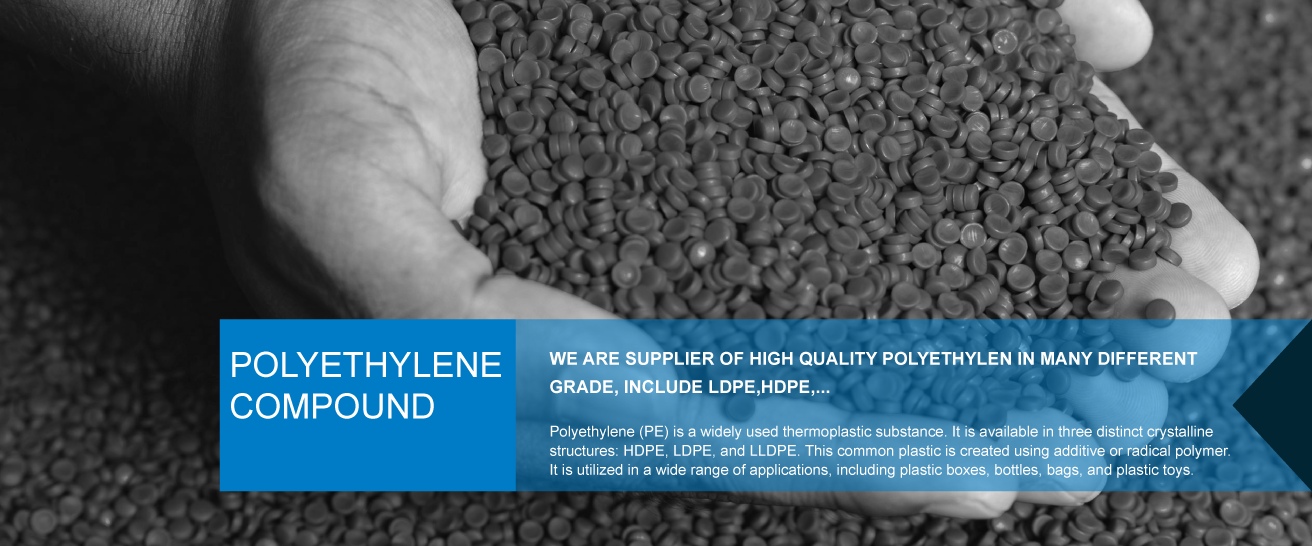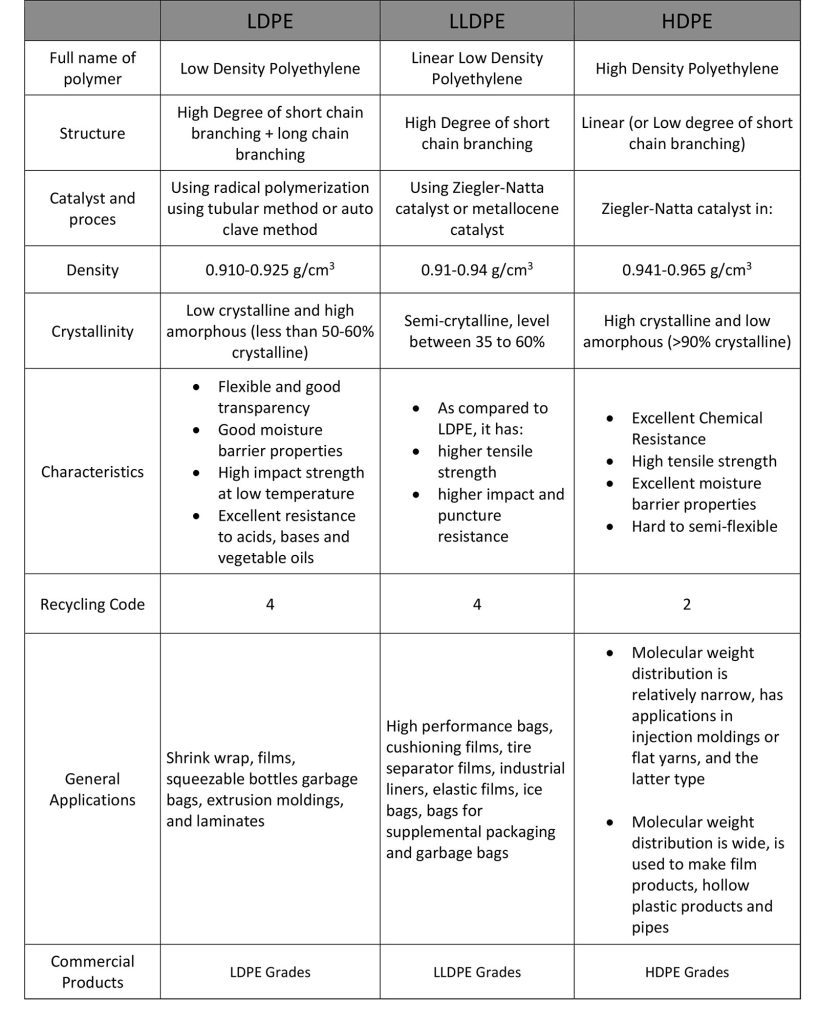
Polyethylene (PE)
Polyethylene (PE) is a widely used thermoplastic substance. It is available in three distinct crystalline structures: HDPE, LDPE, and LLDPE. This common plastic is created using additive or radical polymer. It is utilized in a wide range of applications, including plastic boxes, bottles, bags, and plastic toys.
What exactly is polyethylene?
Polyolefin include polyethylene. This is a lightweight, long-lasting plastic that is commonly used for freezing food containers, bottles, cereal liners, yoghurt containers, and other applications. Look around you: polyethylene is used in all polymers with recycling codes 2 and 4 PE polymers have a variety of crystalline forms. In a moment, we’ll go through subgroups (HDPE, LDPE, LLDPE, and so on).
How is PE created?
PE is created by polymerizing ethylene (or ethane) polymer. The chemical formula for polyethylene is (C2H4) n. Polyethylene chains are synthesized using addition or radical polymer. Metallocene and Ziegler-Natta catalysts are also viable synthesis strategies. A wide range of crystalline structures may be created. We’ll look at how it affects the overall performance.
Most Common Types of Polyethylene (PE)
Different polyethylene grades might function quite differently depending on their porosity and branching. As a result, PE grades are categorized as follows:
Versions with Branches
- Polyethylene with light weight (LDPE)
- Polyethylene linear low density (LLDPE)
Versions that are linear
- Polyethylene with greater density (HDPE)
- High-molecular-weight polyethylene (UHMWPE)
- Polyethylene cross-linked (PEX or XLPE)
Furthermore, PE is available in a variety of forms, including but not restricted to medium-density polyethylene (MDPE)
- Polyethylene of ultra-low density (ULDPE)
- Polyethylene (high molecular weight) (HMWPE)
- Polymerized metallocene (mPE)
- Polyethylene chlorinated (CPE)
Comparison of the Most Common Polyethylene Types
| LDPE | LLDPE | HDPE | |
| Full name of polymer | Low Density Polyethylene | Linear Low Density Polyethylene | High Density Polyethylene |
| Structure | High Degree of short chain branching + long chain branching | High Degree of short chain branching | Linear (or Low degree of short chain branching) |
| Catalyst and proces | Using radical polymerization using tubular method or auto clave method | Using Ziegler-Natta catalyst or metallocene catalyst | Ziegler-Natta catalyst in: |
| Density | 0.910-0.925 g/cm3 | 0.91-0.94 g/cm3 | 0.941-0.965 g/cm3 |
| Crystallinity | Low crystalline and high amorphous (less than 50-60% crystalline) | Semi-crytalline, level between 35 to 60% | High crystalline and low amorphous (>90% crystalline) |
| Characteristics | · Flexible and good transparency
· Good moisture barrier properties · High impact strength at low temperature · Excellent resistance to acids, bases and vegetable oils |
· As compared to LDPE, it has:
· higher tensile strength · higher impact and puncture resistance |
· Excellent Chemical Resistance
· High tensile strength · Excellent moisture barrier properties · Hard to semi-flexible |
| Recycling Code | 4 | 4 | 2 |
| General Applications | Shrink wrap, films, squeezable bottles garbage bags, extrusion moldings, and laminates | High performance bags, cushioning films, tire separator films, industrial liners, elastic films, ice bags, bags for supplemental packaging and garbage bags | · Molecular weight distribution is relatively narrow, has applications in injection moldings or flat yarns, and the latter type
· Molecular weight distribution is wide, is used to make film products, hollow plastic products and pipes |
| Commercial Products | LDPE Grades | LLDPE Grades | HDPE Grades |
How is PE Plastic processed?
Polyethylene in different forms can be utilized in procedures such as injection molding, blow molding, extrusion, and film manufacturing techniques such as calendaring or blown film extrusion.
- Injection molding, extrusion (tubes, blow and cast films, cables, etc.), blow molding, and rot molding are all simple ways to process high density polyethylene. It is mostly utilized for batch and continuous manufacturing since it is a good material for injection molding.
- Extrusion is the most frequent Low Density Polyethylene processing method (tubes, blow and cast films, cables…).
- UHMWPE is treated in a variety of ways, including compression moulding, ram extrusion, gel spinning, and sintering. Because this material does not flow even at temperatures over its melting point, it cannot be moulded using traditional processes such as injection, blow, or extrusion moulding.
- PE (mostly HDPE) is gaining traction as a 3D printing material. Because of its strength, low density, and non-toxicity, it is suitable for a wide range of 3D printed products. Additionally, recycled polyethylene grades and bio-based PE are employed in 3D printing procedures. The sheer availability of PE encourages efforts to use it for additive manufacturing.
| HDPE | LDPE |
| Injection Molding | |
| Melt temperature: 200-300°C
Mold temperature: 10-80°C Drying is not necessary if stored properly High mold temperature will improve brilliance and appearance of the part Mold shrinkage lies between 1.5 and 3%, depending on processing conditions, rheology of the polymer and thickness of the final piece |
Melt temperature: 160-260°C
Post mold shrinkage lies between 1.5 and 3.5% Material Injection Pressure: Up to 150 MPa |
| Extrusion | |
| Melt temperature: 200-300°C
Compression Ratio: 3:1 Cylinder Temperatures: 180-205°C Pre-Drying: No, 3 hours at 105-110 C (221-230°F) for regrind |
Melt temperature: 180-240°C
Higher melt temperatures are needed for extrusion-coating (280-310°C) A three zone screw with an L/D ratio of around 25 is recommended Melt temperature: 160-260°C Post mold shrinkage lies between 1.5 and 3.5% |
Polyethylene’s Most Important Applications
Polyethylene is the most widely used plastic in the world, and it comes in three varieties: HDPE, LDPE, and LLDPE. So, what are some of the most common uses for PE?
Electrical insulation, domestic containers, packaging and films, buckets and bottles are only a few of the applications for polyethylene.
There is no question that the exceptional mix of qualities makes polyethylene an attractive material in a wide range of industrial applications. It can also be designed to meet the needs of the final user. PE may be found in the following applications among the over 6800 Polyethylene grades available on the market today.
- HDPE is commonly used to make crates, trays, bottle caps, drums, and other packaging bottles and films. LDPE is mostly utilized in films, plastic bags, rubbish bags, and other food packaging materials.
- Medical & healthcare – Used to make medical items including patches, personal protective equipment, packaging films, containers, lid stock, and bag headers, among other things.
- Pipes, Hoses, and Fittings – PE components are used in gas pipes, water pipes, sewer pipes, hoses, and other applications, providing good chemical and hydrolysis resistance.
- Garbage containers, kitchenware, housewares, ice boxes, bowls, buckets, ketchup bottles, and so on are examples of household products/consumer goods.
- Agriculture – Polyethylene films are frequently used for greenhouse, walk-in tunnel, and low tunnel coverings, as well as mulching.
- Wire and cable insulation and jacketing can benefit from crosslinked polyethylene or polyethylene copolymer resins.
Polyethylene Recycling and Toxicity
In nature, LDPE and HDPE are non-biodegradable and contribute considerably to global plastic trash. Both types of polyethylene are recyclable and are used to make bottles for non-food items, plastics for outdoor uses, compost bins, and other products.
Polyethylene is harmless and non-toxic in its solid state, however it can be harmful when breathed and/or absorbed as a vapor or liquid (i.e., during manufacturing processes).
PE (HDPE and XLPE) is a popular material for water-related applications. Cross-linked polyethylene (PEX) has gained popularity in recent years for potable water, although it requires specific fittings and is not recyclable. Non-potable water applications employ High-Density Polyethylene (HDPE) pipes. HDPE may be utilized for both hot and cold water supply applications in potable water.
Is polyethylene a good choice for your situation?
PE offers a wide range of applications. It is used in the manufacture of plastic containers, bottles, bags, plastic toys, films, tubes, plastic components, laminates, and so on. Basically, if your application does not require excessive performance, PE might be a good material to use. Polyethylene may compete with engineering plastics in some situations. As you might expect, given its low cost and widespread availability, industry has devised clever methods to test its performance limits.
If you’re still undecided between PE and PP, PET, and PVC… Let’s go through the primary reasons to pick PE over other types of plastics, as well as why it might not be the ideal option.
Polyethylene (PE)
Polyethylene (PE) is a widely used thermoplastic substance. It is available in three distinct crystalline structures: HDPE, LDPE, and LLDPE. This common plastic is created using additive or radical polymer. It is utilized in a wide range of applications, including plastic boxes, bottles, bags, and plastic toys.
What exactly is polyethylene?
Polyolefin include polyethylene. This is a lightweight, long-lasting plastic that is commonly used for freezing food containers, bottles, cereal liners, yoghurt containers, and other applications. Look around you: polyethylene is used in all polymers with recycling codes 2 and 4 PE polymers have a variety of crystalline forms. In a moment, we’ll go through subgroups (HDPE, LDPE, LLDPE, and so on).
How is PE created?
PE is created by polymerizing ethylene (or ethane) polymer. The chemical formula for polyethylene is (C2H4) n. Polyethylene chains are synthesized using addition or radical polymer. Metallocene and Ziegler-Natta catalysts are also viable synthesis strategies. A wide range of crystalline structures may be created. We’ll look at how it affects the overall performance.
Most Common Types of Polyethylene (PE)
Different polyethylene grades might function quite differently depending on their porosity and branching. As a result, PE grades are categorized as follows:
Versions with Branches
- Polyethylene with light weight (LDPE)
- Polyethylene linear low density (LLDPE)
Versions that are linear
- Polyethylene with greater density (HDPE)
- High-molecular-weight polyethylene (UHMWPE)
- Polyethylene cross-linked (PEX or XLPE)
Furthermore, PE is available in a variety of forms, including but not restricted to medium-density polyethylene (MDPE)
- Polyethylene of ultra-low density (ULDPE)
- Polyethylene (high molecular weight) (HMWPE)
- Polymerized metallocene (mPE)
- Polyethylene chlorinated (CPE)
Comparison of the Most Common Polyethylene Types
 How is PE Plastic processed?
How is PE Plastic processed?
Polyethylene in different forms can be utilized in procedures such as injection molding, blow molding, extrusion, and film manufacturing techniques such as calendaring or blown film extrusion.
- Injection molding, extrusion (tubes, blow and cast films, cables, etc.), blow molding, and rot molding are all simple ways to process high density polyethylene. It is mostly utilized for batch and continuous manufacturing since it is a good material for injection molding.
- Extrusion is the most frequent Low Density Polyethylene processing method (tubes, blow and cast films, cables…).
- UHMWPE is treated in a variety of ways, including compression moulding, ram extrusion, gel spinning, and sintering. Because this material does not flow even at temperatures over its melting point, it cannot be moulded using traditional processes such as injection, blow, or extrusion moulding.
- PE (mostly HDPE) is gaining traction as a 3D printing material. Because of its strength, low density, and non-toxicity, it is suitable for a wide range of 3D printed products. Additionally, recycled polyethylene grades and bio-based PE are employed in 3D printing procedures. The sheer availability of PE encourages efforts to use it for additive manufacturing.
| HDPE | LDPE |
| Injection Molding | |
| Melt temperature: 200-300°C
Mold temperature: 10-80°C Drying is not necessary if stored properly High mold temperature will improve brilliance and appearance of the part Mold shrinkage lies between 1.5 and 3%, depending on processing conditions, rheology of the polymer and thickness of the final piece |
Melt temperature: 160-260°C
Post mold shrinkage lies between 1.5 and 3.5% Material Injection Pressure: Up to 150 MPa |
| Extrusion | |
| Melt temperature: 200-300°C
Compression Ratio: 3:1 Cylinder Temperatures: 180-205°C Pre-Drying: No, 3 hours at 105-110 C (221-230°F) for regrind |
Melt temperature: 180-240°C
Higher melt temperatures are needed for extrusion-coating (280-310°C) A three zone screw with an L/D ratio of around 25 is recommended Melt temperature: 160-260°C Post mold shrinkage lies between 1.5 and 3.5% |
Polyethylene’s Most Important Applications
Polyethylene is the most widely used plastic in the world, and it comes in three varieties: HDPE, LDPE, and LLDPE. So, what are some of the most common uses for PE?
Electrical insulation, domestic containers, packaging and films, buckets and bottles are only a few of the applications for polyethylene.
There is no question that the exceptional mix of qualities makes polyethylene an attractive material in a wide range of industrial applications. It can also be designed to meet the needs of the final user. PE may be found in the following applications among the over 6800 Polyethylene grades available on the market today.
- HDPE is commonly used to make crates, trays, bottle caps, drums, and other packaging bottles and films. LDPE is mostly utilized in films, plastic bags, rubbish bags, and other food packaging materials.
- Medical & healthcare – Used to make medical items including patches, personal protective equipment, packaging films, containers, lid stock, and bag headers, among other things.
- Pipes, Hoses, and Fittings – PE components are used in gas pipes, water pipes, sewer pipes, hoses, and other applications, providing good chemical and hydrolysis resistance.
- Garbage containers, kitchenware, housewares, ice boxes, bowls, buckets, ketchup bottles, and so on are examples of household products/consumer goods.
- Agriculture – Polyethylene films are frequently used for greenhouse, walk-in tunnel, and low tunnel coverings, as well as mulching.
- Wire and cable insulation and jacketing can benefit from crosslinked polyethylene or polyethylene copolymer resins.
Polyethylene Recycling and Toxicity
In nature, LDPE and HDPE are non-biodegradable and contribute considerably to global plastic trash. Both types of polyethylene are recyclable and are used to make bottles for non-food items, plastics for outdoor uses, compost bins, and other products.
Polyethylene is harmless and non-toxic in its solid state, however it can be harmful when breathed and/or absorbed as a vapor or liquid (i.e., during manufacturing processes).
PE (HDPE and XLPE) is a popular material for water-related applications. Cross-linked polyethylene (PEX) has gained popularity in recent years for potable water, although it requires specific fittings and is not recyclable. Non-potable water applications employ High-Density Polyethylene (HDPE) pipes. HDPE may be utilized for both hot and cold water supply applications in potable water.
Is polyethylene a good choice for your situation?
PE offers a wide range of applications. It is used in the manufacture of plastic containers, bottles, bags, plastic toys, films, tubes, plastic components, laminates, and so on. Basically, if your application does not require excessive performance, PE might be a good material to use. Polyethylene may compete with engineering plastics in some situations. As you might expect, given its low cost and widespread availability, industry has devised clever methods to test its performance limits.
If you’re still undecided between PE and PP, PET, and PVC… Let’s go through the primary reasons to pick PE over other types of plastics, as well as why it might not be the ideal option.
